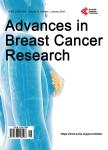Breast Cancer in a Supernumerary Breast at the Yaoundé Gynaeco-Obstetric and Paediatric Hospital: About a Case
Breast Cancer in a Supernumerary Breast at the Yaoundé Gynaeco-Obstetric and Paediatric Hospital: About a Case作者机构:Oncology Department of the Yaound Gynaeco-Obstetric and Paediatric Hospital Yaound Cameroon Faculty of Medicine and Biomedical Sciences of Yaound University of Yaound I Yaound Cameroon Obstetrics and Gynaecology Department of the Yaound Gynaeco-Obstetric and Paediatric Hospital Yaound Cameroon Radiology and Medical Imaging Department of the Yaound Gynaeco-Obstetric and Paediatric Hospital Yaound Cameroon Pathology Department of the Yaound Gynaeco-Obstetric and Paediatric Hospital Yaound Cameroon
出 版 物:《Advances in Breast Cancer Research》 (乳腺癌(英文))
年 卷 期:2024年第13卷第3期
页 面:43-48页
学科分类:1002[医学-临床医学] 100214[医学-肿瘤学] 10[医学]
主 题:Adjuvant Chemotherapy Papillary Adenocarcinoma Surgery Supernumerary Breast Treatment of Supernumerary Breast Cancer
摘 要:Accessory or ectopic breast tissue is an anomaly in the development of the breast. It is a rare condition that occurs along the embryological mammary line. In less than 1% of all breast cancers, supernumerary breast cancer is reported, with the axillary location being the most common in 60% to 90% of cases. Cancerous degeneration of this supernumerary breast tissue can pose a dual diagnostic and therapeutic problem. We report the case of locally advanced adenocarcinoma in a right supernumerary breast. This is a 75-year-old, grand-multiparous, postmenopausal, and known hypertensive patient on treatment. Family history was remarkable for brain cancer in her sister and oesophageal cancer in her mother. She consulted for a mass in the right axillary cavity on supernumerary breast evolving for a year. Clinical examination revealed a large, fixed, budding and haemorrhagic-ulcerated mass of the right axilla, with long axis measuring about 15 cm. There was as wella supernumerary breast on the left, but without particularity. A soft tissue ultrasound showed a large hypoechoicmass in the right axillary region of 116 mm with areas of central necrobiosis. Morphologically, the breasts were normal. A breast MRI revealed a subcutaneous mass in the right axillary cavity with skin ulceration and satellite lymphadenopathy. The extension assessment revealed liver metastases, and a biopsy of the mass revealed a breast adenocarcinoma. The case was the subject of a multidisciplinary consultation meeting following which a wide excision of the mass was indicated. The histo-pathology analysis results of the surgical specimen were in favour of a triple negative papillary adenocarcinoma. After a post-operative multidisciplinary consultation meeting, adjuvant chemotherapy was indicated. The development of supernumerary breasts depends on hormones, just like normal breasts. Breast cancer in accessory breast tissue is quite rare with the incidence being 6%. The most common pathology is invasive



